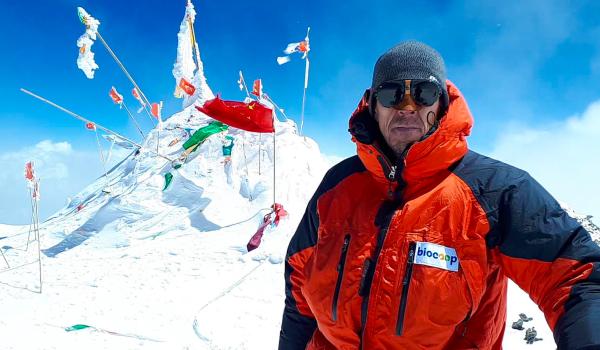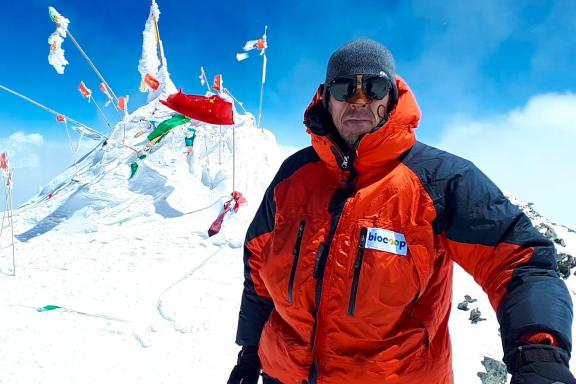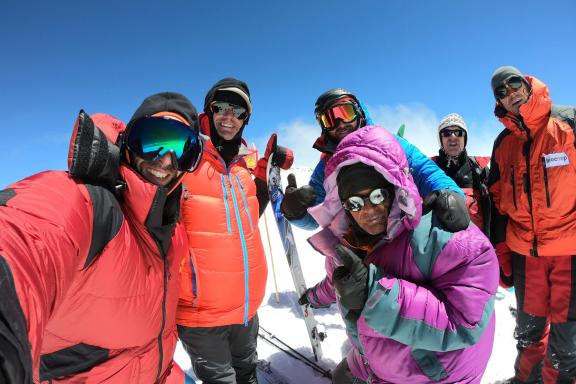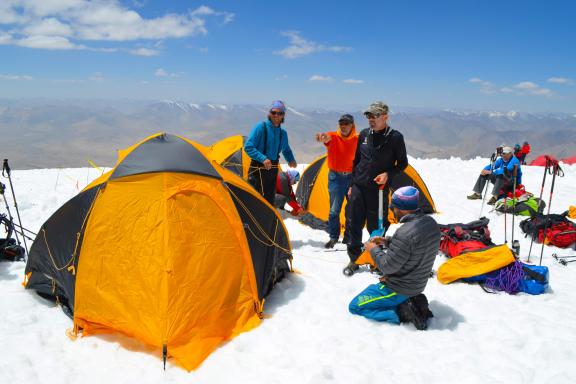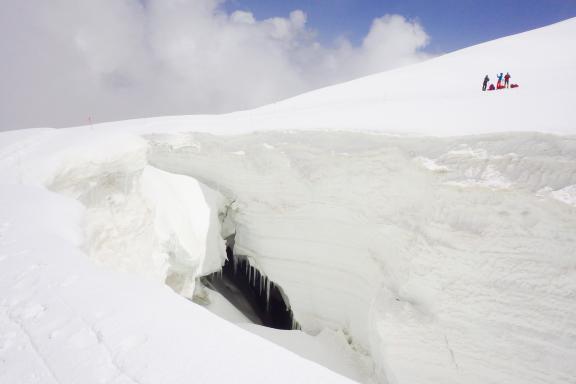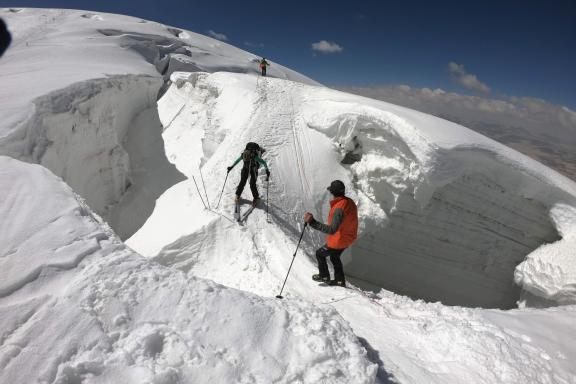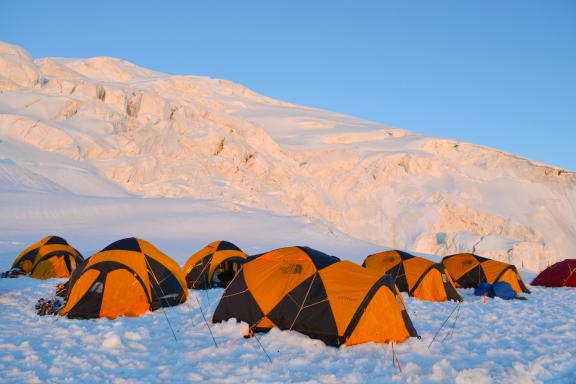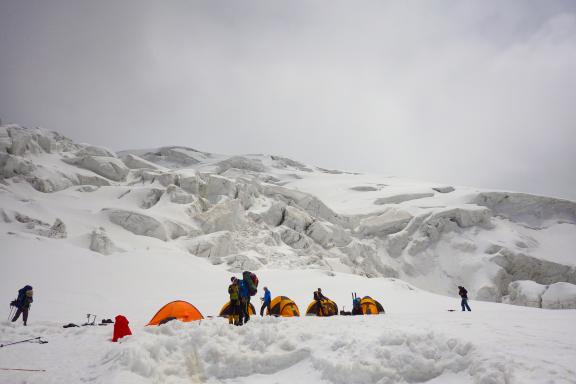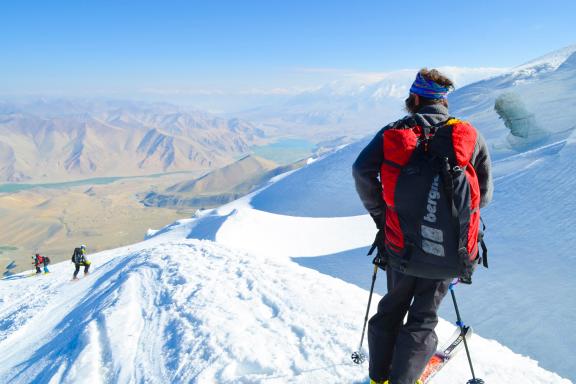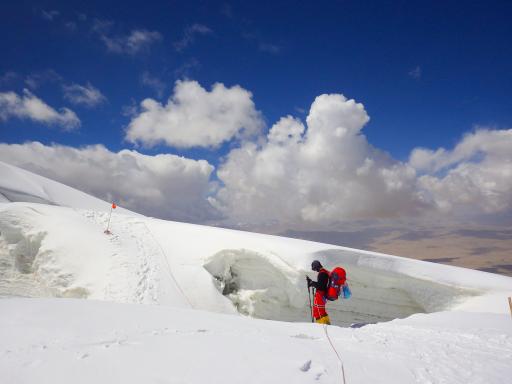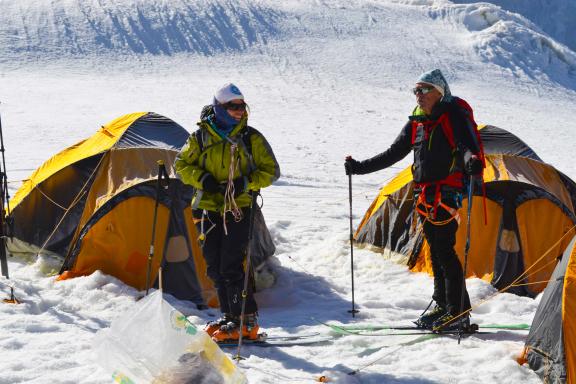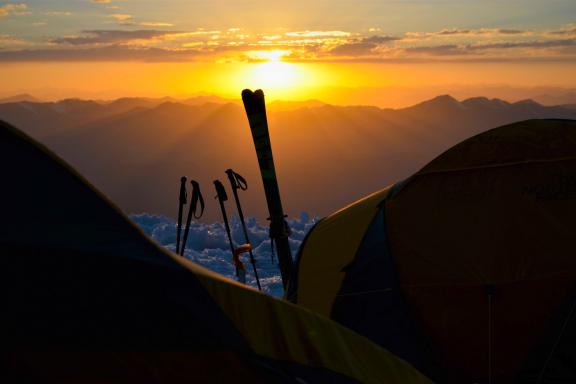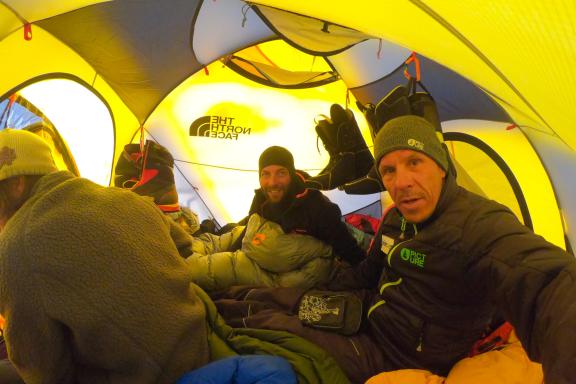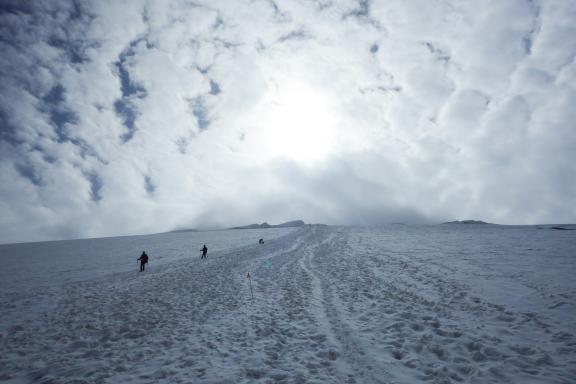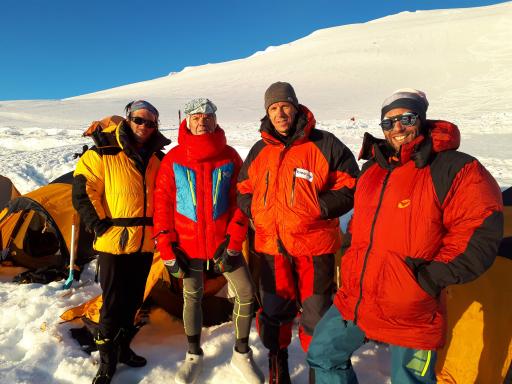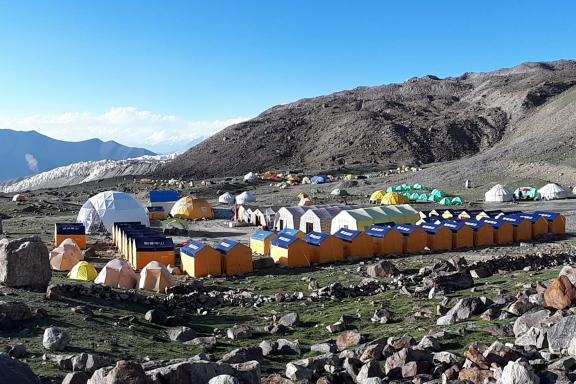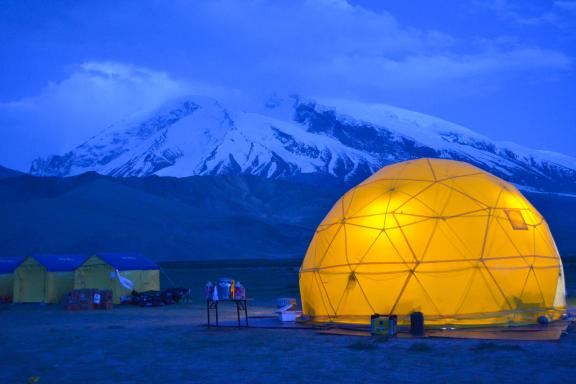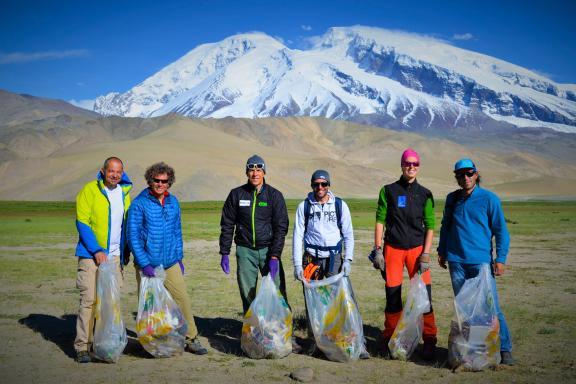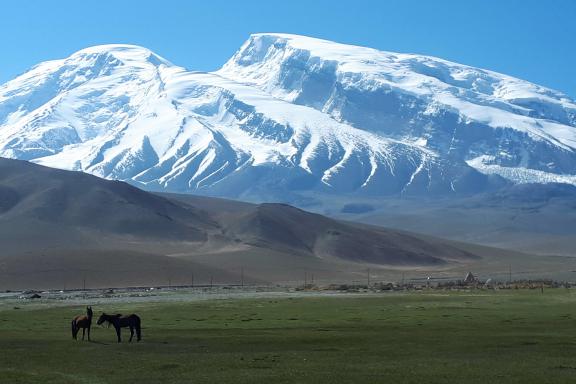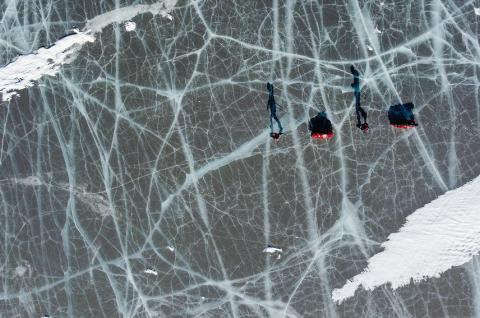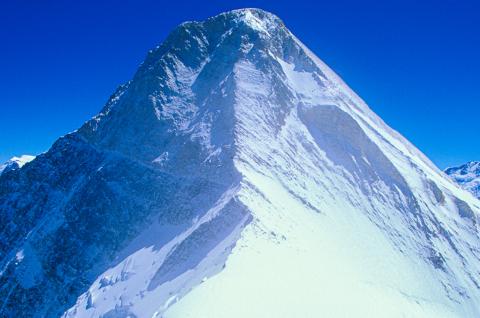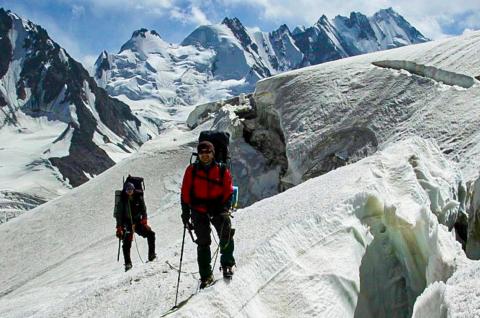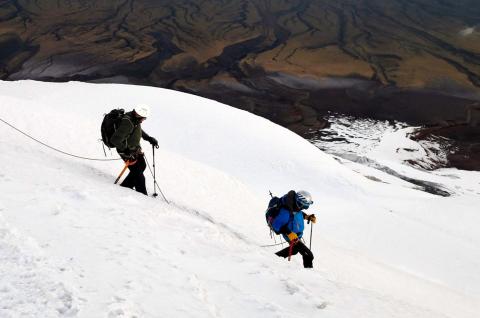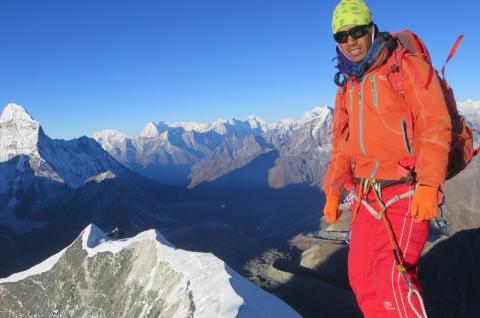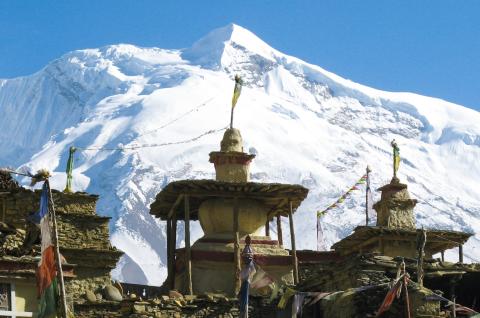A ski ascent of a mythical summit at over 7500 m
Highlights
- Climb a major 7000 m on skis
- Preparing for your first 8000 ascent
- 5 to 7 additional days of acclimatization
- Experienced expedition leader
- A human adventure beyond the physical challenge
- H24 personalized weather forecast services and medical hotline
- Preparation course, live expedition monitoring
We attempt to climb Mustagh Ata or Muztaga at 7546 meters, the “Father of the Ice Mountains” in Kazakh and Uyghur, a magnificent isolated peak between Pamir and Kunlun, in Xinjiang on the border with Pakistan. Its altitude, at over 7500 meters, makes it a good preparation and test for a first 8000-meter ascent, or even the ascent of Everest. It is the highest peak you can ski to and from, without being an exceptional skier. The ascent is done between July and August. We follow the normal route, which is technically very accessible. We prefer ski touring to snowshoeing. Cold and wind can also play spoilsport. In 2019, our expedition saw 8 participants reach the summit.
Overview
See images of our ascent of Muztagh Ata.
Climbing Muztagh Ata is an excellent preparation for an 8000er. The ascent from base camp takes between 12 and 16 days, depending on the level of the participants and their degree of acclimatization. Access to base camp from Bishkek in Kyrgyzstan via Kashgar, from Kashgar or from Pakistan via the Khunjerab Pass and the K.K.H. (Karakoram Highway), takes you through sumptuous landscapes.
You will discover the life of the highland herders, be they Tajik, Uyghur, Kazakh or Kyrgyz, and pass through towns with their legendary markets and bazaars. The Kashgar bazaar, in particular, has lost some of its lustre, it must be said, but the place remains fascinating and bustling.
The best time to climb it is from mid-June to mid-September. But in recent years, the weather has often deteriorated from mid-August onwards, so we plan to climb it between mid-July and mid-August.
Our École de l'Aventure advanced mountaineering courses can be a real asset, both for building confidence and for gaining autonomy. A preparation course is planned in Chamonix in the months leading up to our expedition, date to be confirmed with the group.
And discover our animated itinerary of the Muztagh Ata ascent.
Itinerary
Days 1 & 2: Flights Europe — Bishkek and transfer to Naryn
Day 1
We arrive at Bishkek airport in the morning and are greeted by our partners. We set off directly for Naryn, which we reach in the afternoon. We spend the night in a hostel or yurt camp.
Day 3: Naryn — Kashgar
Day 3
We head for the Chinese border and the Torugart pass (3750 m), which we reach after 2-3 hours (180 km). We get out of the car and complete the formalities, which can take a little time. We can feel the altitude a little, as we are now at almost 4000 meters. We meet the Chinese team and drive south towards Kashgar, which we reach after 3-4 hours (170 km). We may be escorted. In Kashgar, we are taken to our hotel. Depending on the schedule, we have some free time to visit Kashgar, where we will return after the expedition.
Day 4: Kashgar — Subash
Day 4
Early in the morning, we head for Subash along the famous Karakorum Highway. En route, we pass Lake Karakul, at an altitude of 3900 meters, with its beautiful scenery and backdrop of gigantic snow-capped mountains, including the imposing “Father of Mountains”, Muztagh Ata. The landscape also features gorges, canyons and lakes. We then continue on to Subash, the starting point of our trek to the Muztagh Ata base camp, accompanied by our camels.
Day 5: Subash — Base Camp
Day 5
After breakfast, we load up our camels and head for the Muztagh Ata base camp at an altitude of 4450 meters.
Days 6 to 25 : Acclimatization and ascent of Muztagh Ata (7546 m)
Day 6 to 25
Sixteen useful days, with 4/5 days to spare in case of bad weather. We then define our ascent program with our expedition leader and the local tour leader. We may decide to do it on skis or snowshoes, depending on the wishes of the group. It is true that the descent from the summit to Camp 1 (at 5100 meters), a descent of almost 2500 meters, can also be done on skis for good skiers, which is not unpleasant! This is our preferred option. If there are any non-skiers in the group, then we will go back down the same way we came up, on foot and with snowshoes. We will clarify this with the group in the months leading up to the expedition. By way of illustration, the program for the ascent might look something like this:
DAY 5: Rest at base camp (4450 m) and definition of approach tactics.
DAY 6: Climb to Altitude Camp 1 (AC1) at 5100 meters. Return to base camp.
Number of trek/ski hours: 2 to 4 hours from BC to AC1 and 1 to 2 hours back.
DAY 7: Rest at base camp (4450 m).
DAY 8: Ascent to Camp 1 at 5100 meters and overnight in tents at AC1.
Number of trek/ski hours: 2 to 4 hours from BC to AC1.
DAY 9: Ascent to Altitude Camp 2 at 6200 meters and overnight in tents at AC2. Approximately 2 to 4 hours of trek.
Number of trek/ski hours: 2 to 4 hours from AC1 to AC2
DAY 10: Return to base camp (4450 m).
Number of trek/ski hours: 2 to 4 hours from AC2 to BC
DAY 11: Rest at base camp (4450 m) and preparation for ascent.
DAY 12: Ascent to Camp 1 at 5100 meters and overnight in tents at AC1.
Number of trek/ski hours: 2 to 4 hours from BC to AC1.
DAY 13: Ascent to Altitude Camp 2 at 6200 meters and overnight in tents at AC2.
Number of trek/ski hours: 2 to 4 hours from AC1 to AC2
DAY 14: Ascent to Altitude Camp 3 at 6800 meters and overnight in tents at AC3.
Number of trek/ski hours: 3 to 5 hours from AC2 to AC3
DAYS 15 & 16: Ascent of Muztagh Ata summit at 7546 meters, then descent to altitude camps.
Number of trek hours (D15): 7 to 8 hours AC3 to the summit, then return to AC3 or AC2 to spend the night.
Number of trek hours (D16): 4 to 5 hours from AC2 to BC
DAYS 17 TO 24: four contingency days for acclimatization and weather window, or even five if we are skiing.
Day 26: Base Camp — Subash — Kashgar
Day 26
On day 26 at the latest, we meet up with our camels and head back down to Subash, where we are back in our vehicle for Kashgar, which we reach in the evening.
Day 27: Kashgar
Day 27
The day is entirely devoted to exploring the city of Kashgar. At our leisure, we visit the city's main points of interest: the Mausoleum of Abakhoja, leader of the Sufi in the 17th century, and the Eidkah Mosque, built in 1442, as well as the surrounding streets. We will also make sure of visiting the bazaar, a famous market where the different peoples of Central Asia once gathered to trade and sell.
Day 28: Kashgar — Naryn
Day 28
We head for the Kyrgyz border and the Torugart pass (3750 m), which we reach after 3 to 4 hours' driving (170 km). Formalities at the border post, then on to Naryn, which we reach after 2-3 hours (180 km). We spend the night in a hostel or yurt camp.
day 29: Naryn — Bishkek
Day 29
We reach Bishkek in the early afternoon and are driven to our hotel. Last evening.
Day 30: Return to Europe
Day 30
After breakfast, our driver picks us up to take us to the airport. Flight to Europe. Landing the same day in the evening.
END OF EXPEDITION
For reasons that cannot be foreseen at this stage, such as unpredictable weather, the physical fitness or lack of fitness of participants or other circumstancess (customs formalities, road conditions, traffic, landslides, force majeure, etc.), your expedition leader may have to adapt the program, if necessary, to ensure the smooth running of your trip. He remains the sole judge and the one who guarantees your safety. Activity times are given as an indication and may vary from one participant to another.
The itinerary for all our expedition programs, or the ascent program for our high-mountain expeditions, are given here as a guide only. They are flexible enough to adapt to weather conditions with a few contingency days. In any case, you should follow the recommendations of your guide, who may suggest that you cancel your expedition due to weather, safety or physical conditions.
It is important to remember that this is a truly unsupported expedition, and that anything can happen. Expeditions Unlimited, your expedition leader, your guide or our local teams can in no way be held responsible.
Any costs incurred as a result of a change in the expedition schedule (extra nights' accommodation, extra flights) will be borne by the participants and not by the organizers. "Contingency days" refer to the expedition in the strict sense of the term (base camp/base camp in the mountains, departure point/exit point on a traverse, etc.).
Any early return of the expedition or of certain members only (early success, abandonment, etc.), generating costs for accommodation, meals, changes to air tickets or other activities not provided for in this program, will be charged in full to the participants.
Trip notes
Guiding
You have an experienced French expedition leader who has coordinated several high-altitude expeditions. He plays an important role in implementing the strategy required for success: rotation in the high-altitude camps, acclimatization of each participant, study of weather reports to decide on the optimum moment to launch the summit push.
Given the logistics of this summit, he takes part in the carrying, and also guides you in the altitude camps to supervise the smooth logistical running of the expedition. He takes any necessary decisions that may be required. His authority is absolute and inescapable. You must respect his decisions, as well as those taken collectively. The expedition leader represents Expeditions Unlimited in dealings with the group, our partners and local authorities.
For groups of 9 or more, a second English or French-speaking mountain guide will be provided.
Finally, local staff are on hand to welcome you in Kashgar and take you to base camp.
At base camp, a Chinese tour leader is on hand to advise the group on approach and ascent strategy. It is shared with other expeditions. At base camp, too, you will have your own cooking team.
Each participant is responsible for carrying his or her own personal belongings and high-altitude food to the high altitude camps... And probably for a good part of the collective equipment, which must be reduced to its simplest form.
Indeed, in Mustagh Ata, it is very difficult to find available and competent porters. Your expedition leader has a budget for collective equipment (around twenty kilos), just in case he can find personnel.
And throughout the program, we will rely on other local skills as needed. Finally, we will have access to experienced and personalized weaher forecast services and a high-altitude doctor from Ifremmont (see above).
For unpredictable reasons at this stage, like adverse weather conditions, insufficient physical condition of participants, insufficient competencies of participants related to the intended activities, your guide may decide to adjust the intended program and/or activities. At all times, his decision will be final on all matters likely to affect the safety and well-being of the trip.
Difficulty level
Level rated: difficult
This program is aimed at participants in good physical shape, with a significant sport practice, endurance in particular, holding a strong mental to face difficulties that are unforeseen by nature.
You need to have significant mountaineering experience, and active hiking, trekking or mountaineering experience to be as self-sufficient as possible. You need to be able to progress in a roped party, either on your own or roped up with your guide, and to know how to handle ropes. You must be a good skier to be able to ski down 2500 meters, without any technical difficulties, but with a more limited possession of your physical capacities than at 2000 meters altitude. A magnificent experience. The ability to ski smoothly on all types of terrain, both on and off track, is therefore required.
During the expedition, we do all we can to ensure that collective equipment (tents, stoves, gas, etc.) is carried between the various high altitude camps by local porters. That said, the carrying culture in this part of the world is very different from that in the Himalayas, for example, and we cannot reserve these porters in advance. As a result, carrying is not guaranteed.
At most, you can carry ten to fifteen kilos (including personal belongings and food rations) to Camp 1, six to ten kilos to Camp 2, and a little less to Camp 3, although the guide may suggest “skipping” Camp 2 and setting up the last camp between 2 and 3, thus carrying a little less.
Next, it is essential to be well-prepared physically and mentally, given the hostile environment (remoteness, cold, bad weather, discomfort) and medically, to optimize the chances of success. Team spirit is also essential. Each participant is responsible for applying safety rules, looking after his or her own equipment and maintenance, setting up camp and preparing meals. As always in this type of project, the key to success is teamwork and team spirit.
Participation in the preparatory course, the date of which will be specified at a later date, is therefore compulsory. You will also be asked to provide an expedition / trek / sports CV for each participant, enabling us to measure the participant's ability to successfully complete the project with a high probability of success. A medical certificate stating that you have no contraindications to mountaineering at altitude is also required. Preparatory mountaineering courses at our École de l'Aventure can be a real asset, both for building confidence and for gaining autonomy.
Take advantage, free of charge and for the duration of your expedition, of the H24 7/7 high-latitude medical service set up with our partner Ifremmont. See below.
Technical difficulty
Mountaineering level: F like... Easy (Facile in French!)
In this program, the use of mountaineering equipment (crampons, harness, ice ax, ropes, etc.) is necessary but the route covered does not involve any technical difficulty. It is therefore aimed at beginners or even participants who have never practiced. Clearly, a little prior experience in the activity can be interesting, knowing how to equip yourself, knowing how to tie a few essential knots. The mountaineering courses at our Adventure School from three days are for you. And this technical rating applies of course to normal weather conditions: the difficulty can increase in the event of bad weather conditions, fresh snow on rocks, insufficient or lack of quality of the ice, etc. Likewise, the situation changes radically, for the same technical level, with the altitude, the weight of the bag, the lack of equipment on the route, the fatigue associated with the approach if it is long, the environment if particularly hostile, etc.
Programme sans aérien
We meet in Bishkek or Kashgar, where we are met at the airport by our local teams.
Given the diverse origins of the participants on this trip, international outward and return flights are not included in this package. In most cases, we book flights on your behalf to ensure that the whole group arrives at the destination at the same time. We do not charge any fees for these air bookings. Please do not hesitate to contact us. If you book your own tickets, we will advise you on the ideal flight schedule to enable all participants to arrive within a reduced time frame. At the very least, you need tickets that can be modified.
Accommodations
Hotels in Bishkek and Kashgar 3* local standards in double room with breakfast. Single supplement of 150 euros. In an 8-person yurt in Subash. In double North Face VE25 expedition tents from base camp. These will be “pushed” to the higher camps as we go along, leaving one in place at each camp in case of a hasty descent, so that at Camp 3 we will probably be “sleeping” 3 to a tent, in order not to overload ourselves unnecessarily and to remain in the spirit of a high-altitude expedition.
Meals
In Kashgar, meals are not included, leaving you free to roam and stop wherever you like. During the expedition, meals are prepared by the local team using local produce up to the base camp. Beyond the base camp, and therefore from the high altitude camps onwards (probably between six and ten days), meals are prepared by us on the basis of rations that we will have organized prior to our expedition, to ensure the best nutritional/weight/weight ratio. These rations include coffee and tea, cereals, mashed potatoes, soups, broths, Chinese noodles, freeze-dried dishes, snacks, etc., in pre-packaged vacuum-packs to save space.
Transfers / Transport
Transfers to and from the airport, and to and from the expedition starting point, are provided by 4x4 vehicle or minibus.
Group size
The group is composed of 5 to 10 participants maximum. The number of participants is deliberately limited to allow for greater immersion, to avoid embarrassing our hosts, and to develop freedom and flexibility. However, the maximum number may be exceeded if the last person to register wishes to travel with one or more other people. The services will not be modified, and the conditions of the trip will remain the same.
Equipment
Personal equipment is not provided. However, a complete list is provided to allow you to check that you are taking what is necessary.
Our commitments to sustainable development
Our commitment to a better planet has been a reality since the beginning of our story but we always need to do more and better. Please find out more about our charter and our commitments in terms of sustainable development. We have drafted our charter and take action through six themes on which we act as concretely as possible, most often with you: social equity and cultural respect, preservation of water, waste management in expedition, protection of biodiversity, raise public awareness on these subjects and finally, the optimization and recovery of CO2 emissions.
Regarding carbon emissions, most of which are due to air travel, we calculated and communicated in 2018 on the carbon footprint of each of our programs, expressed in tonnes of CO2.
These calculations made us aware of the importance of the total carbon emissions generated by our activity. Also, we have committed in 2022 to a carbon reduction that we believe is unprecedented in the tourism industry, aiming to reduce the total emissions of our activity by 5% per year, taking 2019 as the reference year (3,430 tonnes of CO2). This commitment is in line with the trajectory of the Paris climate agreements of 2015, the current benchmark. Thus, in 2030, we commit ourselves not to exceed 2,160 tonnes of C02. Thus, our maximum “carbon” budget for 2024 is 2,950 tonnes and for 2025, this budget will be reduced to 2,800 tonnes. And so on until 2030. To find out more about all of our calculations and our commitments in terms of reducing our carbon emissions.
In addition, since 2019, we have been encouraging you when you book for your journey to contribute with a donation to an independent NGO, among the two we have selected that share the commitments made in our charter. We matched the amount of this donation to this program's carbon footprint. Thus, the journey you are considering generates 3,3 tons of CO2, which corresponds to a 100% donation of €99 for an estimated value today of €30 per tonne of CO2. This donation remains of course optional and you can decide to give between nothing and 100% of this amount. Since 2019, including covid years of 2020 and 2021, we have been able to collect thanks to you nearly €7,000 for these associations.
Please do not hesitate to come back to us with any questions you might have regarding this carbon footprint mechanism, our other sustainable développement commitments or even to share with us your experience through a chat or a mail at contact@secret-planet.com.
Expedition leader
We rely on the most experienced high altitude expedition leaders. They are part of our close community and co-opt each other. They know each other well and respect each other.
For this expedition, the expedition leader has not yet been formally appointed, but should be shortly.
In addition to their exceptional expeditions experience, our expedition leaders have the know-how to optimize the expedition's chances of success, both in terms of group management and in terms of the pace at which the group builds up its strength and progresses in altitude, key elements in this type of expedition.
Departures and pricing
Please find below all dates and prices for this expedition. Prices are quoted "from" and may be adjusted notably according to the number of participants (see trip notes for details). Please note that dates and prices for years beyond 2024, when given, are for guidance only and are subject to change and readjustment to take account of current economic realities.
No date works for me!
I initiate a new datePrice includes
Transfers tel qu’indiqués dans le programme. Accommodations tel qu’indiqués dans le programme. Meals tel qu’indiqués dans le programme. Guiding tel qu’indiqués dans le programme. Travel folder tel qu’indiqués dans le programme.
Price does not include
International flights. All accompaniments, accommodations or meals mentioned “not included” in the program. Drinks and personal “extras”. Other supplements linked to a lower number of participants registered, your desire to customize or privatize the expedition. The mandatory expedition complementary insurance.
Your custom expedition
We put our expertise, our knowledge of the terrain, our creativity, our experience, the quality of our guides and the reliability of our partners at your service to build your custom expedition. We can also personalize an expedition to your wishes as soon as you form a "closed" group, whatever the number of participants.
This means that, unless you authorize us to do otherwise, no outside participants join you, and we can personalize your expedition by adapting it to your own pace, with the program extensions you desire, a higher level of comfort, certain activities, other encounters, etc.
Every expedition of this type is subject to a specific quotation. To get in touch with us now, please fill in the short questionnaire below. One of our experts will get back to you to refine your request and make you a proposal.
